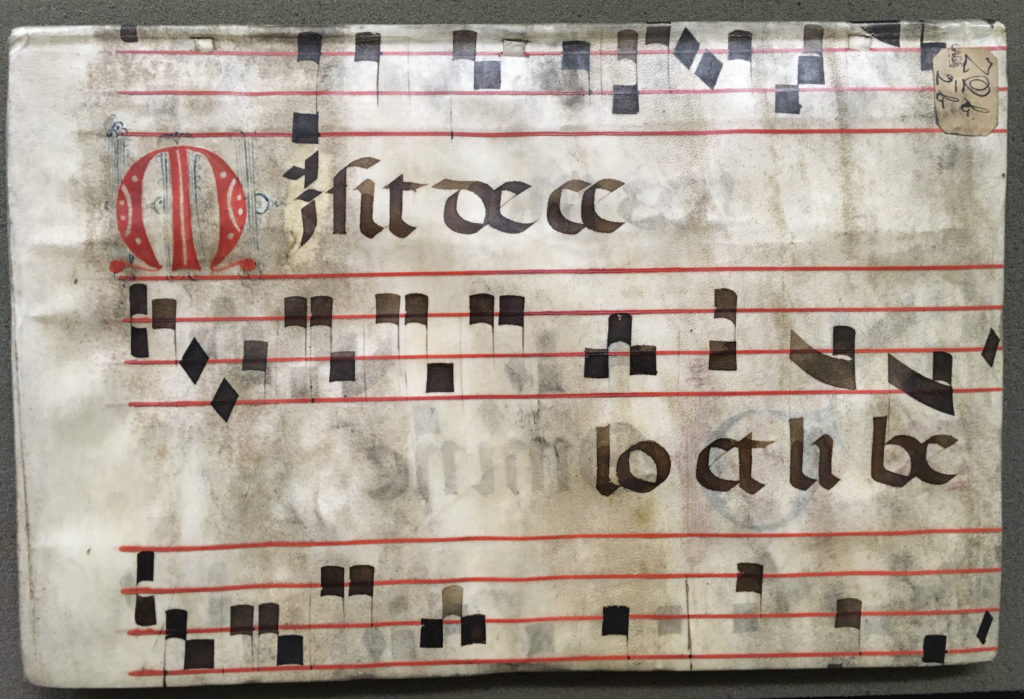Medieval monks were expected memorize all 150 psalms, and they were commonly sung as part of Mass and the Divine Offices. The music on this binding appears to be part of Psalm 56: “Misit de c[a]elo et liber[avit]…”.
Psalm 56 was often used as the Gradual verse (after the reading of the Epistle). It was generally sung on Ash Wednesday, and sometimes during the feast of St. John the Baptist (June 24).
In dating this manuscript, I briefly looked at two things: the script, and the music notation. The script is similar to the one in 10a 210 (Arnald of Villanova’s Regimen sanitatis…, circa 14th c.) – it is a Gothic script, and more rounded and less compressed than littera textualis (a common script during the 13th century and used often for liturgical texts). I am inclined to lean towards putting the creation of the manuscript in Italy, southern France, or the Iberian Peninsula because of the roundness of the letters; Insular and northern European manuscripts favored narrower letters.
The music notation is somewhat more difficult since I’m not a scholar of music, and I haven’t read all that much about medieval music. From what I can gather, the first ‘standard’ modal notation – in which the rhythmic value of notes depended on their context – didn’t appear until the 12th century. By the 13th century, this system was further defined, as individual notes each represented their own rhythmic values based on their shape (think of ‘long’ and ‘short’ notes today), rather than relying on context. However, during the 14th century, the range of note values expanded as they became more specific, and music began to be parsed into sections by using measures.
I did look at an example of a 14th century music manuscript, because I was wavering between putting our manuscript in the 13th or the 14th century. I chose Livres de Fauvel, Paris, B.N. Fr. 146 (ca. 1318). There are some pretty big differences between our manuscript and B.N. Fr. 146, least of all the script – even taking into account that B.N. Fr. 146 is a copy of the poem Roman de Fauvel, and not a missal or antiphonary.
So, based on the script and my (brief, but hopefully accurate) scan of medieval music notation, I believe this manuscript is 13th century, and probably from Italy, southern France, or the Iberian Peninsula.
As always, thoughts and comments welcomed!
The book: Augustis, Quirico de. Lumen apothecarioru[m] cu[m] certis expositionibus nouiter impressum. Venice: Joannes and Gregorius de Gregoriis, de Forlivio, 22 Sept. 1495. ZQb 2b 1495.
Sources:
Clemens, Raymond, and Graham, Timothy. Introduction to Manuscript Studies. Ithaca, New York: Cornell University Press, 2007.
Lacoste, Debra (Project Manager and Principal Researcher) and Koláček, Jan (Web Developer). Cantus: A Database for Latin Ecclesiastical Chant — Inventories of Chant Sources.
Psalm 56 (57). Parallel Latin/English Psalter. Medievalists.net. Undated.
Monti, James. A Sense of the Sacred: Roman Catholic Worship In the Middle Ages. San Francisco: Ignatius Press, 2012.
Strayer, Hope R. “From Neumes to Notes: The Evolution of Music Notation.” Musical Offerings 4, no. 1 (Spring 2013): 1-14.
Tamer, Christina. “Music in Medieval Manuscripts.” From Tablet to Tablet: A History of the Book class project website. English 450.001, University of Michigan. Winter 2013.
Tillerson, Dianne. Medieval Writing: History, heritage, and data source. 20 February 2016.
Wikipedia contributors. “Ars nova.” Wikipedia, The Free Encyclopedia. Accessed 28 September 2017.
—–. “Gradual.” Wikipedia, The Free Encyclopedia. Accessed 28 September 2017.

